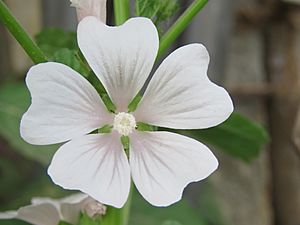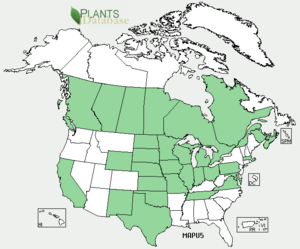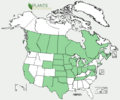Malva pusilla facts for kids
Quick facts for kids Malva pusilla |
|
|---|---|
 |
|
| Malva pusilla at Shravanabelagola | |
| Scientific classification | |
| Genus: |
Malva
|
| Species: |
pusilla
|
| Synonyms | |
|
Malva rotundifolia L. |
|
The Malva pusilla, also known as the low mallow or small mallow, is a type of plant. It's an herb that lives for one or two years. It belongs to the Mallow genus called Malva. This genus is part of the plant family known as Malvaceae. The Malva genus has about 30 different kinds of plants, all called mallows. You can find mallows growing in many parts of the world. They grow in warm, mild, and tropical places.
Contents
Where the Low Mallow Grows
The Malva pusilla plant originally comes from parts of Europe, Turkey, Caucasia, and northwest Iran. But it has spread and now grows in other places too. It can be found in North America, more parts of Europe, and Korea.
In the United States, you can find this plant in many states. These include California, Illinois, Michigan, Ohio, Texas, and Wisconsin. It grows in many different areas across the country.
Where Low Mallow Lives
Malva pusilla is a tough plant that can grow in many different places. You often see it in empty lots, grassy fields, and along roadsides. It can also grow easily in a garden. It likes soil that is moist and rich in nutrients. It also needs a sunny spot to grow well.
However, some animals like rabbits enjoy eating this plant. It can also get infected by a type of fungus called rust fungus.
Why Low Mallow Can Be a Problem
Even though some mallows are grown as garden flowers, some types are considered weeds. This is especially true in places where they didn't grow naturally. Malva pusilla can grow very quickly in gardens and on farms.
It can be hard to get rid of this plant. This is because it has long, strong roots that go deep into the ground. When it grows among farm crops, it can take up a lot of space and nutrients. This means it competes with the crops, which can cause problems for farmers.
What the Low Mallow Looks Like
The stems of the Malva pusilla plant can grow to be about 4 to 20 inches tall. Its leaves are attached to the stem in an alternating pattern. This means they are not directly opposite each other.
The leaves are shaped like a wide triangle or circle. They have veins that spread out like fingers from the center. The edges of the leaves are also slightly jagged. In the past, mallows were sometimes called "cheesepants." This was because their seed pods look a bit like a triangular slice of cheese.
Low Mallow Flowers and Seeds
The flowers of the Malva pusilla plant have five petals. These petals are usually white, but sometimes they can be a very light pink. They often have pink lines running through them. The petals and the green parts under the flower (called the calyx) are usually about the same length.
The flower has many stamens, which are the male parts that produce pollen. These stamens are joined together at their base. The plant starts to bloom in June or July and continues until September or October. The flowers grow in small groups of 2 to 5. You can find them where the leaves meet the stem.
The flower makes a sweet liquid called nectar. Insects help to pollinate the flowers. This means they help move pollen so the plant can make seeds. Each flower usually produces 8 to 12 seeds. These seeds are arranged in a circle. The seeds have a very tough outer layer. This allows them to stay hidden in the soil for a very long time, sometimes up to 100 years! The seeds usually start to grow in late spring when the temperature is between 15 and 20 degrees Celsius.
How People Use Low Mallow
Plant Dyes
You can get different colors from the Malva pusilla plant. Dyes can be made from the plant itself and from its seed heads. These dyes can create colors like cream, yellow, and green. The root of the plant can even be used like a toothbrush!
Food Uses
Some types of mallow plants are eaten as leafy vegetables. The leaves and seeds of Malva pusilla are safe to eat. They have a mild and pleasant taste. You can add them to salads for a fresh flavor.
Medicinal Uses
Malva pusilla has been used for its medicinal properties. The leaves are known as a demulcent. This means they can help soothe and relieve minor pain. They can also help with swelling in the body's membranes. People have used them to help with swelling in the digestive and urinary systems.
The seeds of the Malva pusilla can be used to help with coughs and bronchitis. They have also been used for ulcers and hemorrhoids. You can also put the plant on your skin to help with skin problems. While there are no signs that this plant is dangerous to humans, its leaves can have high levels of nitrates. This can be harmful to animals if they eat too much of it.
Images for kids




